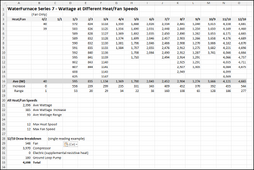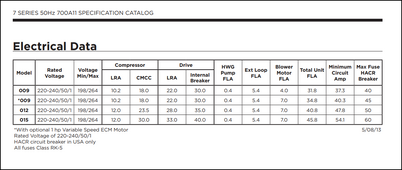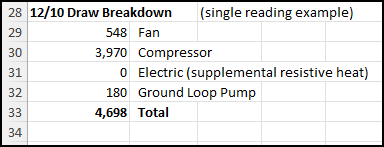Hi Everyone,
Wanted to figure out the power draw that was going to be applied to a Sol-Ark 15K-2P, that I am considering installing. The double-pole breakers used by the geothermal unit, should split the load evenly across both busbar legs (L1, L2), so not imbalance the inverter.
Trying to work out the maximum combined load from the (compressor, fan, loop pump) throughout the range of heating loads/speeds in our 2,100 sqft home. The unit speeds are constantly variable which gives the greatest efficiency. Each home will be unique in its Manual J calculation, so power draw on their geothermal unit, but I thought sharing this data might help someone else with ballpark figures if they are considering this setup.
Heating gives the greatest loads, cooling much less, so the spreadsheet just shows the heating power draw monitoring (at this time). This does not take into account our backup resistive heating elements 15kW that can assist in an emergency, or if you wish to bump the temperature up rapidly. Typically with geothermal for maximum efficiency, you leave the temperatures alone or program the controller to increase in 1-2F degree increments (in the mornings, if you like to sleep in cooler temperatures) to avoid engaging the resistive heat.
Geothermal works best maintaining a constant temperature than rapidly increasing temperatures over a wide range, that's when you need to engage the backup heat source (in our case resistive heat elements).
For resistive heat you need to be grid/generator tied, to make up the difference between inverter output and load, otherwise it will trip a single Sol-Ark 15K-2P inverter. You could do it with parallel units and not trip the inverters, but still much better to be grid tied otherwise you will rapidly drain any battery.
99.5% of the time resistive heat is not called in our home, so these figures are the true load on the inverter. Our unit can go down to 4F (-15.56 C) and still maintain temperature without a problem. That's as low as we have experienced in the last two years of our install.

(update 1/17/2024 - New figures for 12/10 heat and draw breakdown)
Spreadsheet: WaterFurnace Power Draw
Hoping this is helpful to someone.
Alastair
Some power load data to share, from monitoring our WaterFurnace Series 7 ground source geothermal unit in cold weather here in Pennsylvania Appalachian Mountains (elevation 669 feet).Wanted to figure out the power draw that was going to be applied to a Sol-Ark 15K-2P, that I am considering installing. The double-pole breakers used by the geothermal unit, should split the load evenly across both busbar legs (L1, L2), so not imbalance the inverter.
Trying to work out the maximum combined load from the (compressor, fan, loop pump) throughout the range of heating loads/speeds in our 2,100 sqft home. The unit speeds are constantly variable which gives the greatest efficiency. Each home will be unique in its Manual J calculation, so power draw on their geothermal unit, but I thought sharing this data might help someone else with ballpark figures if they are considering this setup.
Heating gives the greatest loads, cooling much less, so the spreadsheet just shows the heating power draw monitoring (at this time). This does not take into account our backup resistive heating elements 15kW that can assist in an emergency, or if you wish to bump the temperature up rapidly. Typically with geothermal for maximum efficiency, you leave the temperatures alone or program the controller to increase in 1-2F degree increments (in the mornings, if you like to sleep in cooler temperatures) to avoid engaging the resistive heat.
Geothermal works best maintaining a constant temperature than rapidly increasing temperatures over a wide range, that's when you need to engage the backup heat source (in our case resistive heat elements).
For resistive heat you need to be grid/generator tied, to make up the difference between inverter output and load, otherwise it will trip a single Sol-Ark 15K-2P inverter. You could do it with parallel units and not trip the inverters, but still much better to be grid tied otherwise you will rapidly drain any battery.
99.5% of the time resistive heat is not called in our home, so these figures are the true load on the inverter. Our unit can go down to 4F (-15.56 C) and still maintain temperature without a problem. That's as low as we have experienced in the last two years of our install.

(update 1/17/2024 - New figures for 12/10 heat and draw breakdown)
Spreadsheet: WaterFurnace Power Draw
Hoping this is helpful to someone.
Alastair
Last edited:





